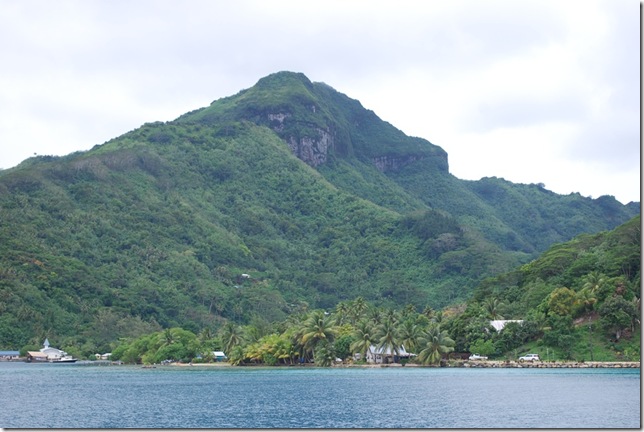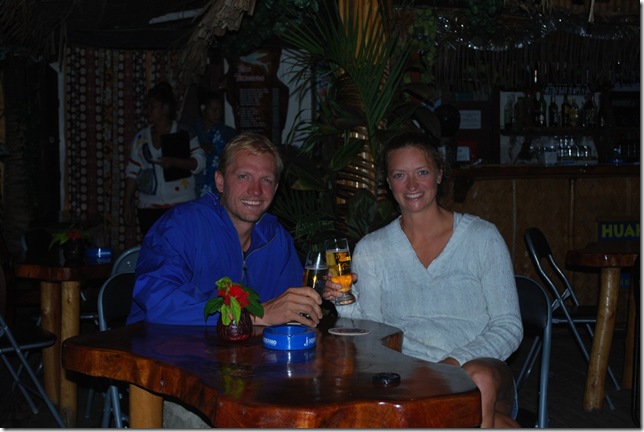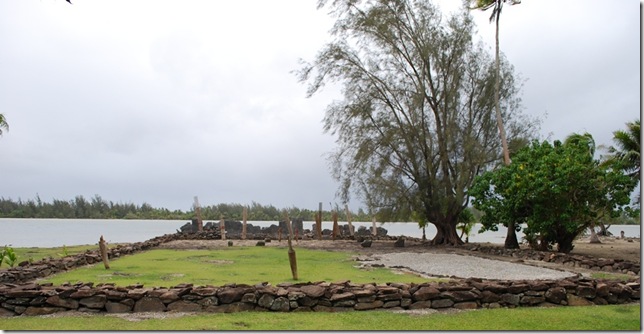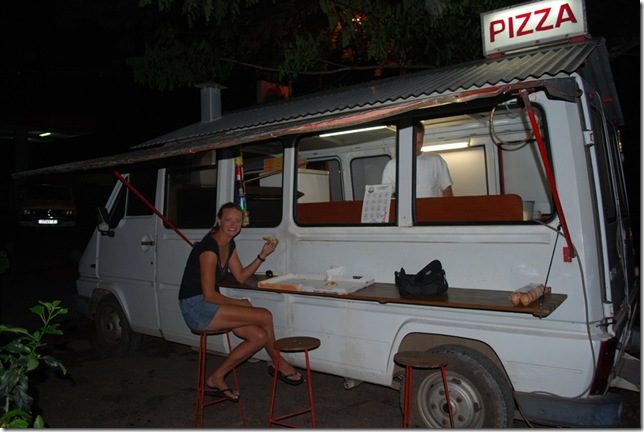We did anchor watches all night in the storm, but our anchor held just fine. Silvio’s advice was to drop the anchor at the drop-off at the edge of the sand bank / lagoon channel, so that the anchor would pull uphill. That worked well, but with all of the coral head and coral on the wall of the channel, getting the anchor up is going to be a challenge. Matajusi tried moving yesterday and I ended up helping them by diving down with scuba gear to free the anchor, which was wrapped around coral. Lauren tried taking a look at our anchor yesterday when she jumped in for a while to relax. The chain was snaking around coral heads and then disappeared over the wall at the edge of sand bank. She followed it down to 30 feet before coming back up. It should be interesting to retrieve today.
If the wind doesn’t get too bad, we’re headed for Raiatea in an hour or so, about 20 miles away. We’ll probably make a short stop of a day or two at the south end of the island and then move on to Bora Bora (another 30 miles), our last official stop in French Polynesia. We should make it there before Dragon, the boat we crewed on through the Panama Canal, has left for Tonga, and it will be nice to catch up with them. We’ve been trading e-mails ever since Panama. Yesterday, we could see Bora Bora on the horizon just north of Raiatea and Tahaa.
 Raiatea (left) and Tahaa (right). Bora Bora is farther right, but hard to see in the pic.
Raiatea (left) and Tahaa (right). Bora Bora is farther right, but hard to see in the pic.
We were planning to move yesterday, but didn’t make it. We got around a little too late to get to Raiatea, and ended up doing some file swapping with Matajusi in the afternoon. They’re getting a bunch of our movies, and we’re getting cruising guides for a good portion of the world.
We finished the day with some time in town. There’s a restaurant/bar by the beach, so I treated Lauren to a few of the draft Hinanos she’s been craving. We also couldn’t resist another pizza from the pizza van. From the tables nearest the beach, you can see the outline of the woman of Huahine in the mountain contours (it’s much easier to “see” at night). She has a bit of a pot or pregnant belly, and the legs take a little imagination, but the face and chest are easily identifiable. It’s been a while since we were sitting in a touristy waterfront restaurant/bar. As cool as it is to watch the sunset, etc. from the boat, it was nice to get off it for a while and enjoy the view with a cold draft and hot pizza.
The woman’s belly, a pretty peak near the anchorage
Today started with a bad harbinger. It was another rainy, windy day, and when we got up I noticed our usually very trustworthy anchor had drug about 80 feet and we were too close to a channel marker. After eating, we moved the boat up and re-anchored closer to the boats in front of us. Just after finishing, we noticed that Matajusi, who were were now fairly close to us had started to pull up their anchor as well. I was initially afraid that they thought we had anchored too close, so when they finished, I dinghied over to explain that we’d drug and say sorry if we’d moved too close. It turns out that they had drug as well after their anchor had snagged and then broken a large piece of coral, so they were moving up as well.
Silvio and I were both headed into the water to check our anchors, so we met beside the boat. He’s a good free diver, and I had thrown on the scuba gear from yesterday, as I still had some air in the tank. When I took a look at the anchor, it seemed to be dug in well, but the cruising guide says the area doesn’t have good holding and I noticed that there were a lot of 3″-6″ pieces of rock, coral, and shell in the sand that seemed to make it difficult for the anchor to really dig. I added a 30 lb. mushroom anchor about 4 ft. from the main anchor to help hold the chain down so that it was pulling on the anchor from the optimum direction, let out another 10 ft. of chain, and headed back down below.
We were checking our position every hour to make sure we weren’t dragging, but about 40 minutes after 5pm, I felt a really strong gust and thought about getting up to check the anchor. Wes and Tiff had braved the rain to go into town, I was in our berth checking e-mail, and Lauren was in the salon Skyping with her sister. A few minutes after the gust, I heard Lauren yell that we were dragging, and I ran up on deck. A loud whistle from our friend Silvio on Matajusi had alerted her, and when we made it out on deck, we were precariously close to the partially awash coral heads. There was coral behind us, heads awash only 50 ft. or so to port, and plenty of heads in the shallow water in front and to starboard of us that our anchor may be fouled on. We were only in 8 ft. of water (our draft is 3.5 ft), and coral heads dotted the bottom all around us.
We turned the engines on, and Lauren took the helm while I ran to the bow to try to get the anchor on board. With the strong wind pushing us onto the heads, shallow water all around, and almost no room to maneuver, it looked like pulling up the anchor and chain was going to be challenging and dangerous. The wind was loud, but it was blowing from the bow to the stern, so Lauren was easily able to hear me when I yelled instructions for quick turns with plenty of throttle to try to get over the top of the anchor. Luckily, after a couple of maneuvers I could see the anchor was loose and hollered back to Lauren to increase the throttle again and head out of the shallow water.
Matajusi had pulled their anchor up as well in the meantime and were headed out of the anchorage. Lauren and I took turns at the helm so we could change from the wet shorts we had run on deck in to dry clothes and foul weather gear. Wes and Tiff were still ashore, so we tried radioing and making a pass near the main dock, but then decided we were going to have our hands full getting the boat safely anchored before nightfall, so we motored off toward the south. There’s a pretty exposed sand bank inside the lagoon that the cruising guide recommends for this type of weather, but I was hoping to find something more sheltered, so we tried the nearby bay just to the south. Unfortunately, it’s a deep bay that doubles as a wind tunnel, and the rain felt like small stones (think sticking your head out of the car window when you’re doing 60 mph in the rain). We made it halfway down the bay and then turned back for the sand bank.
It was dark, but Matajusi had already anchored there and gave us some good tips on where to try anchoring. We finally got the anchor dropped in about 20 ft of water, put out 150′ of chain, and added some heavy-duty chafe-guard for the bridle.
While we waited to make sure things were going to hold, we made contact with Wes and Tiff over the radio and thanked Silvio for his well-timed whistle. They had started to drag at the same time, and had noticed that we were moving quickly toward the reef. Not knowing if we were monitoring channel 16 (we always do), Silvio used his ability to whistle loudly to get our attention. We learned from Spica, the German boat we’ve seen a couple times since Panama and visited last night, that a French boat in the anchorage had also had problems. Spica had been able to chase down their dinghy, which had broken loose, but they weren’t answering on 16 and no one knew whether they had moved or had headed offshore to ride things out.
Once it seemed like things were holding, Wes and Tiff headed back to the boat, and we’re taking turns doing anchor watches tonight, as the wind is gusting over 45 kts and seems to just be getting stronger.
There’s a saying that says sailing is 99% boredom and 1% sheer terror. We were never at any personal risk, so we didn’t break too far into the 1%, but the boat was one loud whistle and about 50 feet from having a really bad day, and that definitely got the blood pumping.
Believe it or not, we’ve been here since Friday, and Lauren and I just took our first trip ashore yesterday. We’ve enjoyed a couple days of snorkeling, diving, and catching up on e-mail. It’s been overcast and rainy most of the time we’ve been here, but you’re going to get wet diving anyway, and even overcast days don’t hide the beauty of the island.
Huahine came well recommended from a number of people and they didn’t steer us wrong. It’s a high island, like the Marquesas, but the mountains have softer, less rugged contours and include some beautiful tree varieties that aren’t found in the Marquesas. In addition to the surrounding lagoons, the Society Islands in general enjoy a coastal plain region that circles the island at its base. Nearly all of the population lives in this strip of fairly flat land, along a main road that rings the island. It’s a change in population density from the inhabited but isolated valleys of the Marquesas and makes it very convenient to explore the island by bicycle (if anyone knows how to repair a slightly bent rim before it gets worse, let us know). The freedom of movement allowed by the coastal plain areas probably also played a role in these islands having a more united government and religious organization than the Marquesas.
Huahine has been inhabited since about 850 AD. The ancient name for the island means "joyous breeze", but at some point it was changed to the current Huahine, which refers rather explicitly to a member of the female anatomy ("Hine" means woman and translations of "Hua" apparently include hole and sex). There’s a legend that says the name of the island comes from a princess who escaped nearby Raiatea by floating away inside a large drum. She and the warrior who found her named the 10 regions of the island after their children. It’s been interesting to hear the island legends that explain names and origins of the various places, but it does seem a little unlikely that the Tuamotus were formed by a strong storm that knocked off some pieces of the Marquesas. The name is also said to come from the outlines of the mountain peaks, which supposedly look like a woman lying down when viewed from the beach here at Fare. The other story we heard is that the name is derived from a round bay on the east side of the island with a large, natural basalt column towering above it. At any rate, even though the island is reputed to be endowed with femininity and was ruled by a Queen when Cook arrived, Lauren’s certain is was actually named by a man. Apparently the people of Huahine weren’t too keen on becoming French. There were a number of battles and Huahine wasn’t annexed until 40 years after Tahiti, with the population not getting French citizenship until 1945.
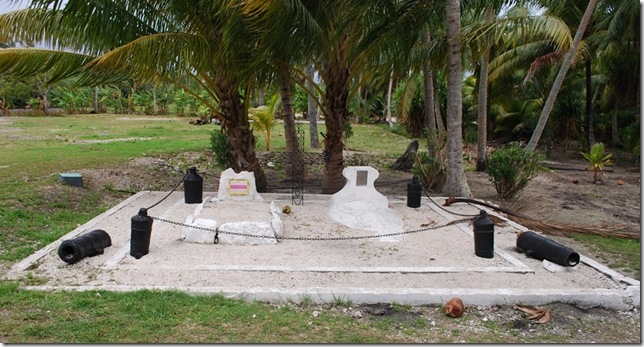 Memorial to those killed in the battles between the French and the natives
Memorial to those killed in the battles between the French and the natives
In addition to being a beautiful emerald ring around the island, the lagoon provides a lot of recreation and resources. The locals are frequently out canoeing and fishing and the diving is great. The swell from the south creates some incredibly picturesque surf waves, but with a jagged reef marking their final destination, I think I’ll wait for a sandy beach to make another effort at learning to surf. When Lauren and I finally made it ashore, we re-traced the path Wes and Tiff had taken. On the north side of the island there’s a large lagoon with a small river-like entrance that is actually referred to as a lake. Fish parks are common here and in the Tuamotus as a method of raising fish to sell in Tahiti, but here there is also an ancient method of building stone walls in the channel that feeds into the northern lagoon to route and capture ocean fish. The stone walls don’t appear to be in use anymore, but there were definitely active fish farms in the area.
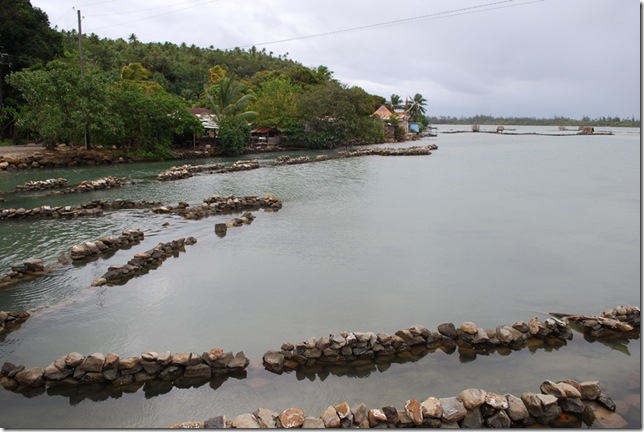 Stone walls in the foreground and a fish farm in the background
Stone walls in the foreground and a fish farm in the background
Along the way, there was an area where there are a number of marae by the lagoon, which are a bit different here than in the Marquesas. Here they are large, open areas paved with stone and featuring a single raised area. There aren’t any tikis or carvings, and much of the structure and ornamentation was made of organic materials, so there’s not much left to see besides the foundations, though the size and lagoon-side setting are memorable.
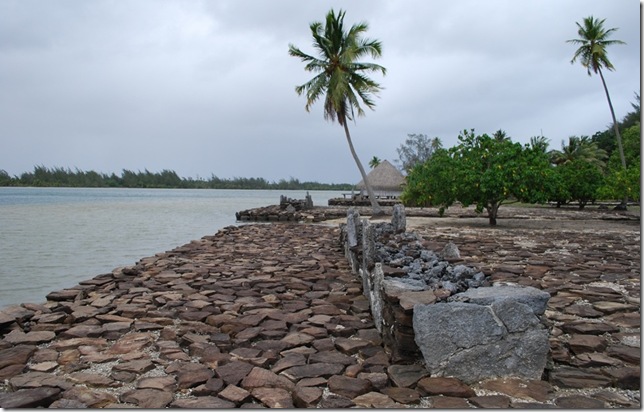 Three adjacent marae at the edge of the lagoon
Three adjacent marae at the edge of the lagoon
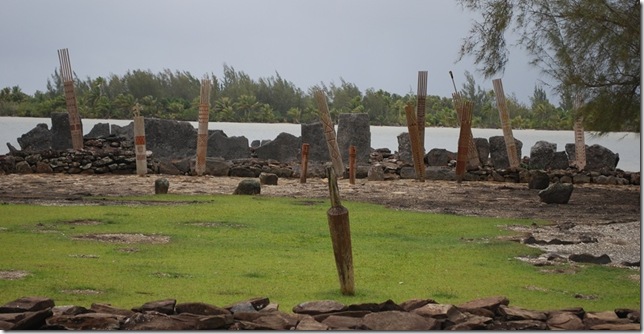 Wooden carvings decorating the large marae
Wooden carvings decorating the large marae
Not much was open when we made it back to town Sunday night, but we did find something that sparked our interest: a pizza van! This time the thin-crust pizza was incredibly good. Tbe ingredients were all western-style and the pizza was cooked in a small pizza oven inside the truck. After diving and biking, we were hungry enough that we almost ordered another one. I’ve been joking about opening up a "Gringo Burrito" stand to make a few bucks in New Zealand since Lauren and I have been making homemade tortillas and burritos, but the pizza option is now under consideration as well.
Just when you think the list of boat repairs is shortening, you realize the futility of thinking those kind of thoughts. The port engine had done well after tightening the oil pressure regulator until just as we finished anchoring when it started squeaking, just at the edge of the threshold for going off. Luckily, nearby Raiatea is the charter and yachting capital of French Polynesia and if it’s still a problem, we should be able to find a mechanic there. Our sail cover was questionable when we left Florida, and it’s developed numerous tears, but it’s still protecting the main from UV damage and should get us to New Zealand. While the winds are about 25 knots offshore, here they howl down from the mountains and the gusts feel like they’re easily topping 40 knots, but the cover hasn’t blown off yet. Yesterday, we turned the inverter on and the control panel started beeping and displaying an error code. I opened the cockpit locker where the inverter is located and saw smoke coming out of it. I’ll try a bit of troubleshooting at some point, but it’s a well know fact that once the magic smoke has escaped, electronics typically lose their functionality. Luckily we have some small inverters that we should be able to get by with.


